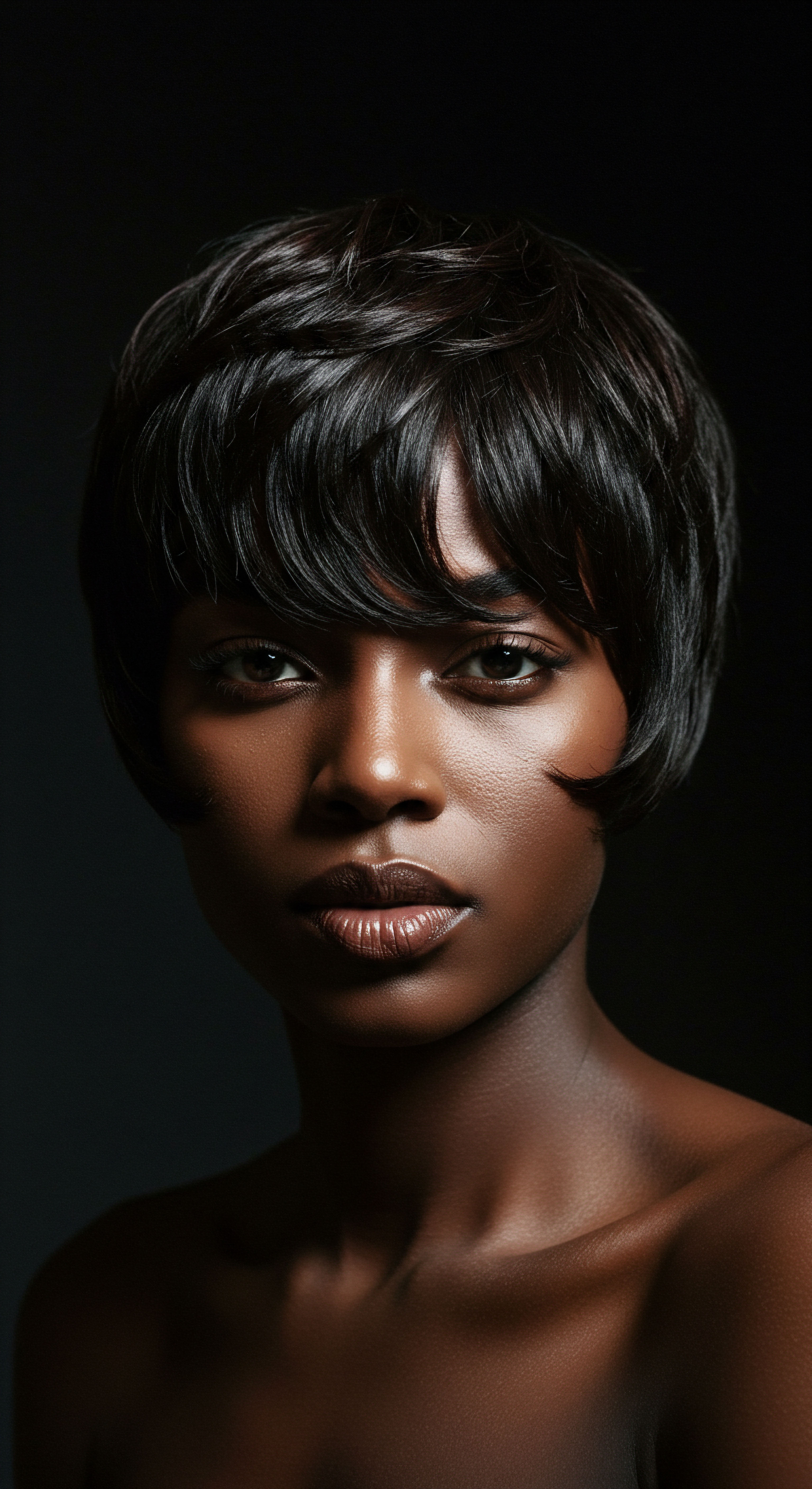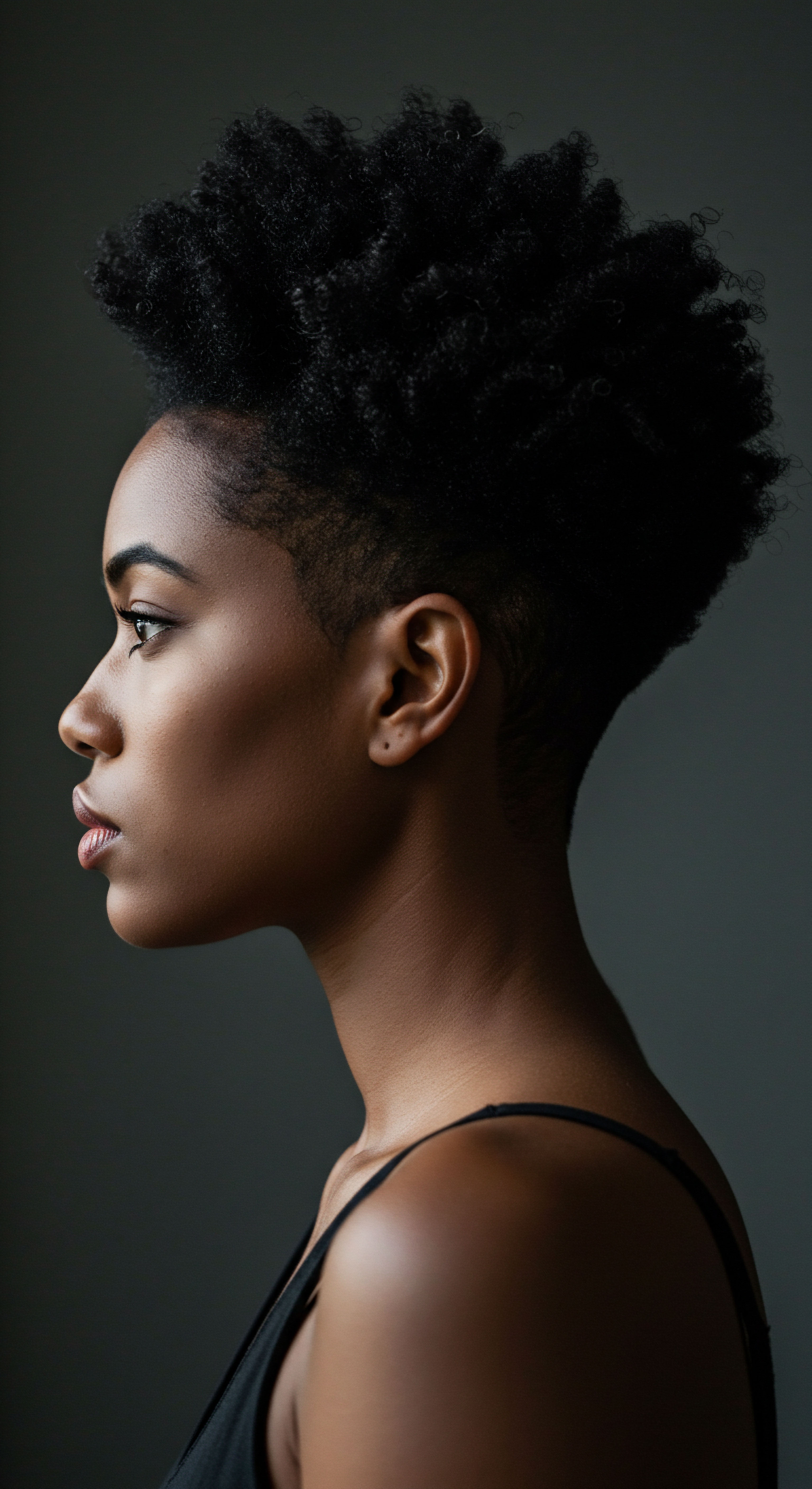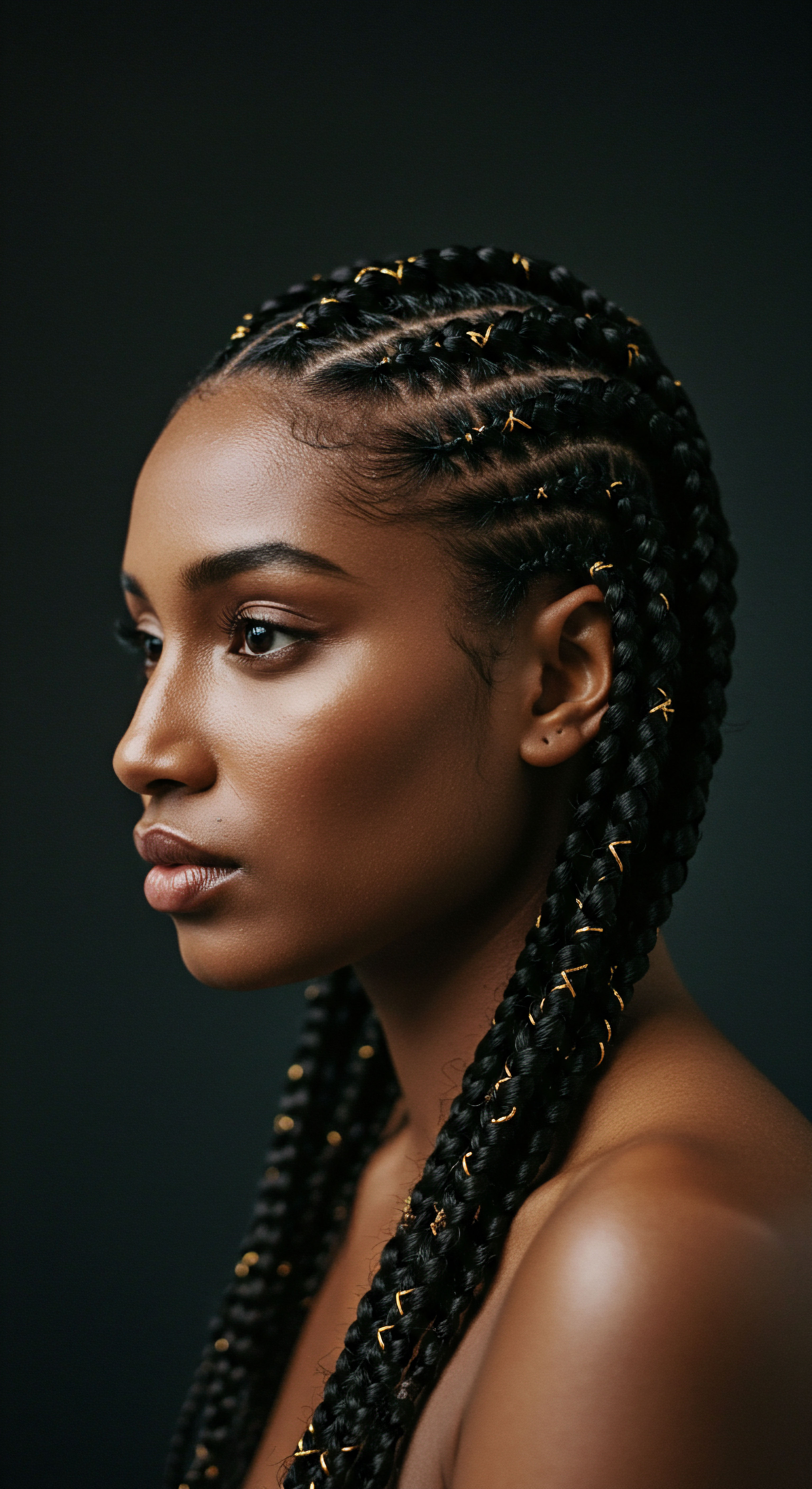
Roots
The quiet observation of hair, a silent language spoken across generations, reveals a profound truth ❉ our strands carry more than just genetic code. They bear the imprints of history, of societal expectations, and often, of legal mandates. How these ancient decrees and more recent statutes have shaped, and continue to shape, the way we adorn our hair is a story etched deeply into personal expression and collective identity. It is a narrative that asks us to look beyond the surface, to consider the unseen forces that have long dictated what is deemed acceptable, beautiful, or even lawful on our heads.

Hair as a Marker of Identity and Control
Across diverse civilizations, hair has consistently served as a potent symbol of social standing, religious devotion, marital status, and even political affiliation. Ancient societies often formalized these meanings through laws, establishing a framework of control over personal appearance. These regulations, often termed Sumptuary Laws, aimed to maintain social order by dictating what individuals could wear or how they could present themselves, including their hair. The underlying intent was to prevent commoners from mimicking the appearance of the elite, thus preserving class distinctions.
Hair has long been a potent symbol of identity, its adornment frequently subject to societal control and legal regulation across civilizations.
Consider ancient Rome, where hairstyles were far from a mere aesthetic choice; they communicated a wealth of details about a woman’s social standing, moral character, and adherence to societal norms. Married women, for instance, typically wore their hair in a complex updo known as the Tutulus, a style signifying respectability and virtue, associated with the goddess Vesta. Conversely, unmarried women often wore their hair loose or in simpler styles, symbolizing their youth and availability for marriage.
Wealthy Roman women could afford elaborate coiffures, often involving multiple hairdressing slaves called Ornatrices, whose very presence and labor underscored the wearer’s affluence. This deliberate cultivation of intricate, often unnatural styles, rather than simple ones, showcased the wearer’s capacity to command significant time and resources for personal adornment.

Medieval Hair Regulations and Social Order
During the European Middle Ages, hair continued its role as a social barometer, with laws dictating appropriate styles based on social position. The burgeoning economic prosperity in the High Middle Ages saw a return of sumptuary laws, with the first secular legislation in over 300 years limiting expenditures on luxury items, including furs used to trim garments. For women, head coverings were particularly significant. Married women were generally required to cover their hair in public, a custom rooted in biblical injunctions, rendering the veil a symbol of a respectable, married woman.
Such regulations were not always met with passive acceptance. In 1326, the women of Florence petitioned the Duchess of Calabria to ease legislation preventing them from wearing false hair, a clear indication of how these laws directly impacted personal expression and desires for adornment. These legal constraints served a dual purpose ❉ to prevent the blurring of class lines and to enforce religious or moral standards. The very act of wearing a particular head covering or hairstyle could instantly convey one’s ethnicity, class, gender, marital status, and religious calling.
- Roman Hairstyles ❉ Reflected social status, marital status, and adherence to public decorum.
- Medieval Head Coverings ❉ Signified marital status, piety, and social class distinctions.
- Sumptuary Laws ❉ Legal frameworks designed to regulate appearance and reinforce social hierarchies.

Ritual
The daily rhythms of hair care, the careful detangling, the precise sectioning, the thoughtful application of product, all speak to a deeper practice. These are not merely tasks; they are rituals, often imbued with meaning that stretches back through time, sometimes in defiance of historical constraints. As we consider how historical laws continue to shape contemporary hair adornment, we recognize that our techniques and practices are not simply personal preferences, but rather responses, adaptations, and often, acts of cultural reclamation.

Colonial Hair Control and Resistance
A particularly poignant instance of legal intervention in hair adornment is the Tignon Laws of 18th-century Louisiana. Enacted in 1786 by Spanish Governor Esteban Rodríguez Miró, these laws mandated that free women of color in New Orleans cover their hair with a headscarf, known as a Tignon. The underlying motivation was to control the perceived extravagance and social mobility of these women, many of whom were of African descent and had achieved a degree of economic independence. Their elaborate hairstyles, often adorned with jewels and feathers, were seen as a challenge to the established social order and a threat to white women, who perceived them as competitors for status and attention.
The Tignon Laws, a historical decree, aimed to suppress the visibility of free Black women’s hair in colonial Louisiana, yet spurred creative acts of resistance.
The impact of these laws was profound, yet the response was a testament to resilience and creativity. Instead of succumbing to the intended suppression, the women transformed the tignon into a powerful statement of cultural pride and individual beauty. They used luxurious fabrics, vibrant colors, intricate wrapping techniques, and adorned their headwraps with their own jewels and ribbons.
This act of re-interpretation, while technically adhering to the law, effectively subverted its oppressive intent, turning a symbol of inferiority into a mark of distinction and defiance. The tignon became an enduring symbol of resistance and cultural heritage, a visually striking fashion statement that celebrated their unique beauty and style.

From Historical Suppression to Modern Expression
The echoes of such historical mandates resonate in contemporary practices, particularly within Black communities. The legacy of laws that sought to control or diminish natural Black hair continues to influence perceptions and experiences. For centuries, hair was weaponized to control, hypersexualize, and de-feminize Black women, with slave owners often shaving the heads of enslaved people to erase cultural identity. The historical pressure to conform to Eurocentric beauty standards led many African Americans to straighten their hair using harsh chemicals, a practice that persisted well into the 20th century.
The Civil Rights Movement saw the emergence of the Afro as a powerful symbol of resistance and pride, directly challenging the prevailing beauty norms. This assertion of natural hair as a political statement has continued to evolve, leading to contemporary movements advocating for legal protections against hair discrimination.
- Tignon Laws ❉ Mandated head coverings for free women of color in colonial Louisiana, sparking creative resistance.
- Afro Hairstyle ❉ A symbol of cultural pride and defiance during the Civil Rights Movement.
- Natural Hair Movement ❉ A contemporary response to historical hair discrimination, seeking acceptance and legal protection.
| Era/Region Ancient Rome |
| Example Law/Practice Married women's 'tutulus' hairstyle |
| Primary Social Intent Signify respectability, marital status, and social control. |
| Era/Region Medieval Europe |
| Example Law/Practice Sumptuary laws on hair adornment |
| Primary Social Intent Preserve class distinctions, enforce moral standards. |
| Era/Region Colonial Louisiana |
| Example Law/Practice Tignon Laws (1786) |
| Primary Social Intent Control social mobility of free women of color, reinforce racial hierarchy. |
| Era/Region Slavery Era United States |
| Example Law/Practice Forced hair shaving |
| Primary Social Intent Erase cultural identity, dehumanize enslaved individuals. |
| Era/Region These historical legal frameworks often sought to regulate identity and maintain social order through hair. |

Relay
How do the faint whispers of centuries-old edicts resonate in the contemporary legal landscape of hair? This question invites us to delve into the intricate interplay of historical prejudice, evolving social norms, and the persistent quest for self-determination through appearance. We observe a profound continuum, where past legislative attempts to control hair expression have given way to modern battles for the right to wear natural hair without penalty. The implications extend far beyond aesthetics, touching upon economic opportunity, mental well-being, and the very definition of professional decorum.

The Persistent Shadow of Hair Discrimination
Despite significant societal shifts, discrimination based on hair texture, particularly against Black individuals, remains a palpable issue in the modern era. This bias, rooted in historical efforts to enforce Eurocentric beauty standards, manifests in workplaces and educational institutions. Instances of Black workers and students facing punishment due to their natural hairstyles, including braids, locs, and afros, have filled courthouses for decades, yielding mixed results. This situation reveals a contentious and uncertain legal environment, where courts and governmental entities have often ruled on opposing sides of the debate.
A striking illustration of this enduring challenge is the case of Chastity Jones. In 2010, Jones’s job offer as a customer service representative was rescinded because she refused to cut her locs, with the hiring manager reportedly stating, “They tend to get messy.” The Equal Employment Opportunity Commission (EEOC) filed a lawsuit on her behalf, yet the case was lost, and the ruling was upheld on appeal in 2016. This particular outcome, while not the sole example, underscores the legal ambiguities and the uphill battle individuals face when their natural hair is deemed “unprofessional.”

Legislative Responses and Their Impact
In response to this persistent discrimination, a legislative movement has gained momentum, particularly in the United States. The CROWN Act (Creating a Respectful and Open World for Natural Hair) seeks to prohibit discrimination based on hair texture and protective hairstyles associated with race. California became the first state to enact such legislation in 2019.
As of July 2024, 25 out of 50 U.S. states have prohibited discrimination based on hair texture.
The statistics surrounding hair discrimination are compelling and underscore the urgent need for such legal protections. Research indicates a significant disparity in experiences:
- Workplace Perceptions ❉ Black women’s hair is 2.5 times more likely to be perceived as unprofessional compared to white women’s hair.
- Job Interview Pressure ❉ Approximately two-thirds (66%) of Black women change their hair for a job interview, with 41% altering their hair from curly to straight.
- Microaggressions ❉ Black women with coily or textured hair are twice as likely to experience microaggressions in the workplace compared to Black women with straighter hair.
- Job Loss ❉ Over 20% of Black women aged 25-34 have been sent home from work because of their hair.
These figures highlight a systemic issue, where appearance policies, even seemingly neutral ones, disproportionately affect Black women, hindering their career advancement and contributing to a sense of professional disadvantage. The CROWN Act aims to address this by legally recognizing that hair-based discrimination is a form of racial discrimination.

The Science of Hair and Societal Perceptions
The societal biases against textured hair often stem from a lack of scientific understanding and deeply ingrained cultural norms. Hair discrimination is a negative bias directed toward Black natural or textured hairstyles, typically worn by persons of African descent. These natural hair textures, including afros, locs, twist-outs, and braids, have historically been viewed as unattractive or unmanageable within a Eurocentric beauty framework.
Modern legislative efforts like the CROWN Act seek to dismantle hair discrimination, a persistent issue with roots in historical prejudice, impacting professional opportunities and well-being.
The impact of this discrimination extends beyond economic ramifications, affecting mental and physical well-being. Individuals who feel compelled to alter their natural hair to conform to workplace or school expectations may experience psychological distress. The costs and time spent on maintaining or styling hair to meet these external expectations can also impact other lifestyle choices and financial stability.
The ongoing legislative efforts, such as the federal CROWN Act which passed the U.S. House of Representatives in 2020 but has not yet passed the Senate, represent a critical step. This bill seeks to overturn centuries of lawful racial discrimination based on hair texture and hairstyles, signaling a move towards a more equitable and respectful environment for all hair types.
| Discrimination Metric Perception of Unprofessionalism |
| Statistical Impact 2.5 times more likely for Black women's hair |
| Discrimination Metric Hair Change for Job Interview |
| Statistical Impact 66% of Black women change their hair |
| Discrimination Metric Microaggressions (Coily/Textured Hair) |
| Statistical Impact 2 times more likely for Black women |
| Discrimination Metric Sent Home from Work |
| Statistical Impact Over 20% of Black women aged 25-34 |
| Discrimination Metric These statistics highlight the ongoing systemic challenges faced by Black women in professional settings due to hair discrimination. |

Reflection
Our hair, in its myriad forms, remains a powerful declaration of self. The journey from ancient sumptuary laws to contemporary legislative battles like the CROWN Act reveals a consistent, undeniable truth ❉ society has always sought to regulate what grows from our heads. Yet, within every decree, every attempted suppression, a counter-current of creativity and defiance has always flowed. The story of hair adornment, shaped by the weight of historical laws, ultimately becomes a testament to human spirit, a vibrant assertion of identity that refuses to be contained by arbitrary rules.

References
- Sherrow, Victoria. Encyclopedia of Hair ❉ A Cultural History. Greenwood, 2006.
- Snook, Edith. A Cultural History of Hair in the Renaissance. Bloomsbury Academic, 2016.
- Gould, Virginia M. Creole ❉ The History and Legacy of Louisiana’s Free People of Color. Louisiana State University Press, 2012.
- Hunt, Alan. Governance of the Consuming Passions ❉ A History of Sumptuary Law. St Martin’s Press, 1996.
- Onwuachi-Willig, Angela. “The CROWN Act ❉ A Jewel for Combating Racial Discrimination in the Workplace and Classroom.” Economic Policy Institute, 2023.
- Pitts, Britney. “Uneasy Lies the Head that Wears a Crown ❉ A Critical Race Analysis of the CROWN Act.” Journal of Black Studies, vol. 52, no. 7, 2021, pp. 716-735.
- Rogers v. American Airlines, 527 F. Supp. 229 (S.D.N.Y. 1981).
- Equal Employment Opportunity Commission v. Catastrophe Management Solutions, Inc. No. 14-13726 (11th Cir. 2016).
- Donahoo, K. J. and Smith, K. E. “The Person Beneath the Hair ❉ Hair Discrimination, Health, and Well-Being.” Journal of Health Disparities Research and Practice, vol. 16, no. 2, 2023, pp. 1-13.